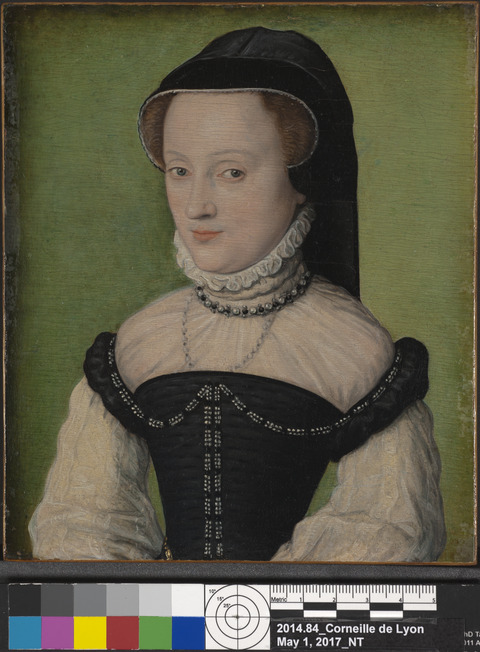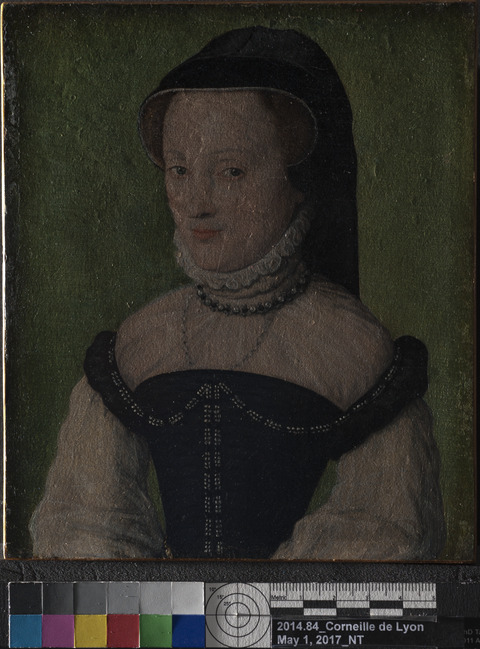Overview
Accession number: 2014.84
Artist: Corneille de Lyon
Title: Portrait of a Woman
Materials: Oil (untested) on marouflaged wood panel
Date of creation: About 1560–1565
Previous number/accession number: C10026
Dimensions: 17.1 × 14.7 cm
Conservator/examiner: Fiona Beckett with contributions from Roxane Sperber
Examination completed: 2014, revised 2019
Distinguishing Marks
Front:
None
Back:
None
Other:
The following labels are present in the conservation file:
Item 1. Damaged off-white rectangular label, trimmed (appears to have been removed from the painting or frame at one point): “Portrait of………..Chantillon” (sic).
Item 2. Damaged off-white circular sticker with blue trim, illegible.
Item 3. Damaged off-white label on thick paper backing board: “…LOWES FUND INCORPORATED/FINE ARTS DEPARTMENT/744 SPRING HOLLOW ROAD/INDIANAPOLIS 8, INDIANA, U.S.A. ………………………………………….”
Item 4. Off-white label on thick paper backing board: “No.5 – Corneille de Lyon/Portrait of the Duchess /de Chatillon.”
Summary of Treatment History
The painting was treated prior to arrival at the IMA collection in 1971, although the exact dates are not known. A previous structural intervention thinned the original panel and marouflaged it to a secondary panel support. A cradle was also added along with edge strips.
Documentation indicates a series of condition assessments and treatments were carried out on the collection around the time the works were moved from the Clowes residence to the IMA. A condition report by Paul Spheeris in October of 1971, likely carried out before the paintings were relocated, described the painting as “O.K.” He described the painting as being in not immediate danger but comments that a “heavy natural resin varnish…is creating an undue amount of surface tension that could possibly cause cupping of the paint layer.” He recommended removal of the varnish to remedy this and enhance the appearance of the painting.1 A second condition assessment was carried out upon arrival of the paintings at the IMA. This assessment describes the work as in stable condition, and no work was deemed necessary. An X-radiograph of the painting was made at this time.2
In 1974, a condition assessment, treatment, and investigation of the collection was carried out by the Intermuseum Conservation Association at Oberlin College. Their report describes this painting as having a natural resin varnish that is yellowing with discoloration along the edges. Treatment was recommended to improve the appearance and loosen the movable cradle.3 A memorandum explaining the charges for this work suggests the recommended treatment was carried out.4 Handwritten information in the conservation file notes that a treatment, likely that proposed in 1974, consisted of removing the natural resin varnish and replacing it with a synthetic Paraloid B-72 varnish. The painting has been examined in the Clowes Collection annual survey since 2011.
Current Condition Summary
Aesthetically, the painting appears to be in good condition. Structurally, the painting is sound despite previous damages. Past splitting and damage to the wood can be seen in raking light, but this appears to have been stabilized and does not present any concern at this time.
Methods of Examination, Imaging, and Analysis
| Examination/Imaging | Analysis (no sample required): | Analysis (sample required): |
|---|---|---|
| Unaided eye | Dendrochronology | Microchemical analysis |
| Optical microscopy | Wood identification | Fiber ID |
| Incident light | Microchemical analysis | Cross-section sampling |
| Raking light | Thread count analysis | Dispersed pigment sample |
| Reflected/specular light | X-ray fluorescence spectroscopy (XRF) | Fourier-transform infrared spectroscopy (FTIR) |
| Transmitted light | Macro X-ray fluorescence scanning (MA-XRF) | Raman microspectroscopy |
| Ultraviolet-induced visible fluorescence (UV) | ||
| Infrared reflectography (IRR) | Gas chromatography–mass spectrometry (GC-MS) | |
| Infrared transmittography (IRT) | Scanning electron microscope -energy dispersive X-ray spectroscopy (SEM-EDS) | |
| Infrared luminescence | Other: | |
| X-radiography |
Technical Examination
Description of Support
Analyzed Observed

Material Type (fabric, wood, metal, dendrochronology results, fiber ID information, etc.):
The painting was executed on wood panel.
Characteristics of Construction/Fabrication (cusping, beveled edges of panels, seams or joins, battens):
The original support is constructed from a single wood panel. The wood grain is in the horizontal orientation with a slight diagonal tilt. The original panel has since been thinned and marouflaged to an additional panel with perpendicular wood grain orientation. A cradle was added to the back of that support (tech. fig. 2). There are wood strips attached to all four edges. The painting was examined for dendrochronology and wood identification, but the structure of the auxiliary support did not allow for either analysis.
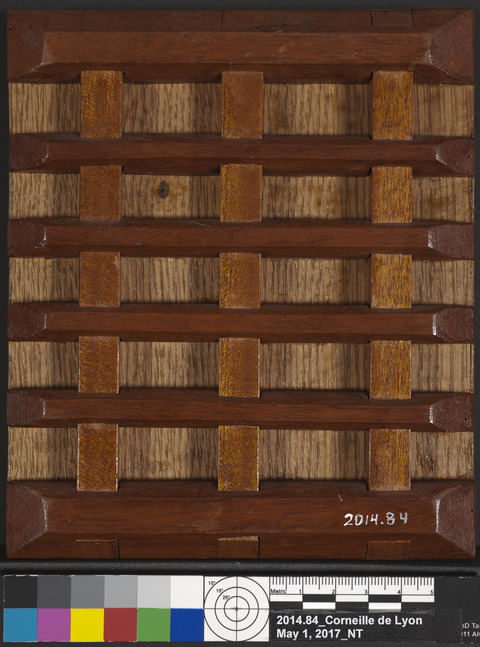
Thickness (for panels or boards):
0.5 cm (original panel and secondary panel together)
Production/Dealer’s Marks:
None
Weave (structure, weight, thread thickness, etc.):
N/A
Auxiliary Support:
Original Not original Not able to discern None
A wooden panel with the wood grain running vertically is attached to the back. A cradle with six fixed horizontal members and three sliding vertical members is attached to the back of this second panel. Edge strips are attached to all four sides, leaving little of the original panel visible.
Condition of Support
The panel is currently in stable condition. It suffered serious damages in the past, including pest infestation (tech. fig. 1). Extensive woodworm channeling can be seen throughout a large portion of the upper half of the panel in the X-radiograph. As seen from the X-radiograph, the boring was filled with what appears to be a dense fill material, possibly containing lead white. Some small nicks, dents, and slight wear of the wood are present around the edges. The cradle is seized, indicating that since the time the cradle was added, the wood support reacted to environmental changes. The cradle and auxiliary panel support appear to be in good condition.
Description of Ground
Analyzed Observed
Materials/Binding Medium:
The ground appears to be a single, thin layer of chalk and glue (likely calcium carbonate, as would be typical for panel preparation in Northern Europe). XRF analysis identified calcium in all areas analyzed. Lead was also identified in every location analyzed, but it is more likely that the lead white is present in an imprimatura or in the upper paint layers than in the ground.
Color:
The ground is off-white, and where visible along the edges, appears to have yellowed slightly over time.
Application:
The ground was likely brushed on after the panel was coated with size.
Thickness:
Relatively thin
Sizing:
While not visible, animal-glue size would have been applied to the panel prior to the ground layer, possibly on both sides.
Character and Appearance (Does texture of support remain detectable/prominent?):
The ground layer is cracked and shows the texture of the wood grain throughout.
Condition of Ground
Where visible, the ground appears to be in stable condition. A cracking pattern exists in the entire ground layer and through the paint layers consistent with that of the horizontal wood grain of the panel. Additional cracking exists in the top left and right corners, which appears as radiating stress cracks (tech. fig. 3). These may be related to thinning of the panel and the addition of the second panel and cradle. There are some small, old losses in the ground layer around the edges of the panel.
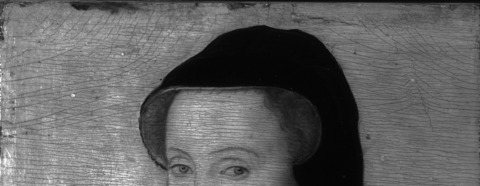
Description of Composition Planning
Methods of Analysis:
Surface observation (unaided or with magnification)
Infrared reflectography (IRR)
X-radiography5
Analysis Parameters:
| X-radiography equipment | GE Inspection Technologies Type: ERESCO 200MFR 3.1, Tube S/N: MIR 201E 58-2812, EN 12543: 1.0mm, Filter: 0.8mm Be + 2mm Al |
|---|---|
| KV: | 21 |
| mA: | 3 |
| Exposure time (s) | 90 |
| Distance from X-ray tube: | 36″ |
| IR equipment and wavelength | Modified Nikon D670 DSLR with a Costal Optics 60 mm 1:4 UV-VIS-IR Apo Macro lens and X-nite 830 filter at a cut-on wavelength 830 nm. |
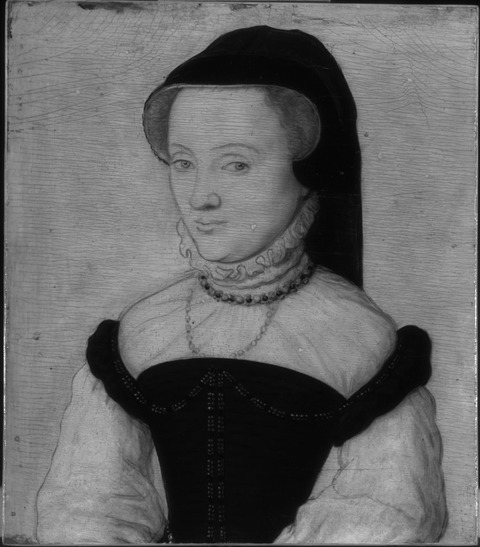
Medium/Technique:
Minimal underdrawing is visible in the infrared photograph (tech. fig. 4). Contours and lines in the figure, face, and the sleeves were lightly sketched with some minor refinements. In other areas, such as the ruffles around the neck, the lines are more prominent. The underdrawing was executed in a carbon-containing dry material, such as charcoal or black chalk, as the lines appear fine and hard-edged. Minor adjustments are visible to the edges of the sleeves, shoulders, and face. Some of the underdrawing also remains visible to the naked eye. Additionally, the visible light photograph and X-radiograph show details on the fabric folds in the woman’s sleeve. These are not visible in the infrared reflectogram, indicating the design was established during the painting phase of the composition rather than during the planning phase (see tech. figs. 5–7).

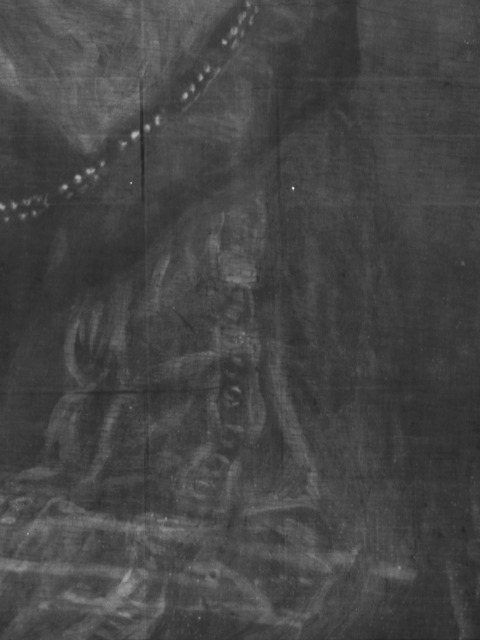
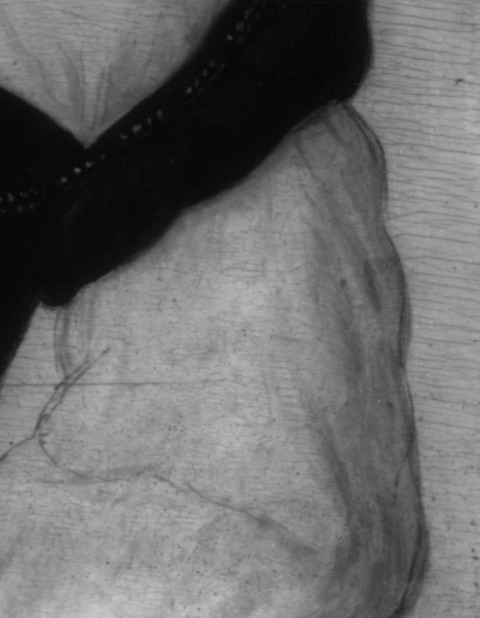
Pentimenti:
No pentimenti are discernible.
Description of Paint
Analyzed Observed
Application and Technique:
The paint is applied in thin layers over a thin ground with some preliminary underdrawing. The features and details are carefully observed and delicately painted with a small brush in deliberate brushstrokes. The eyes are outlined with a dark stroke of paint on the upper eyelid and a subtle range of pinks on the lower lid (tech. fig. 8). The mouth is painted with modulating red tones contrasted by surrounding cool shadows (tech. fig. 9). The pearls around the sitter’s neck and the details in the belt are painted with several colors to create the appearance of reflectance (tech. fig. 10). The pearls are created using black for the shadows and dabs of white, azurite, and lead-tin yellow mixed with white for highlights and reflectance. The ruff is articulated using strokes of lead white over underdrawing (tech. fig. 11). No impasto or heavily painted areas are present. The green background does not extend underneath the figure and extends only slightly under the black headdress. It was likely applied before the figure was fully completed and later reworked to reinforce the contours.
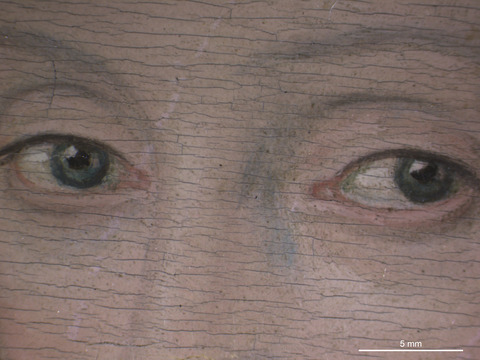
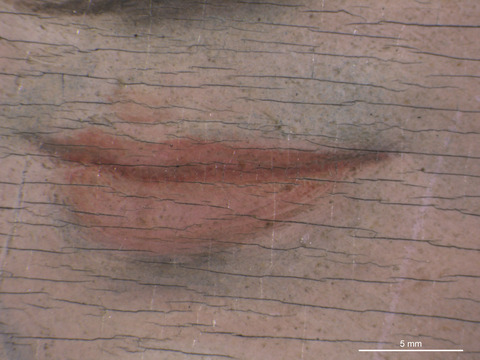
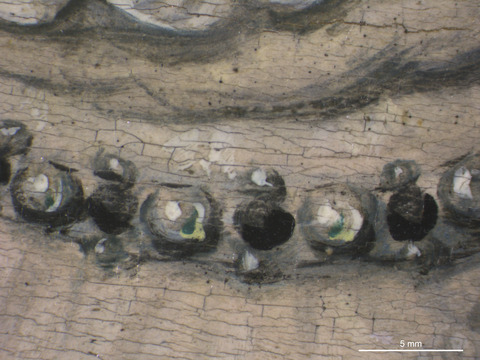
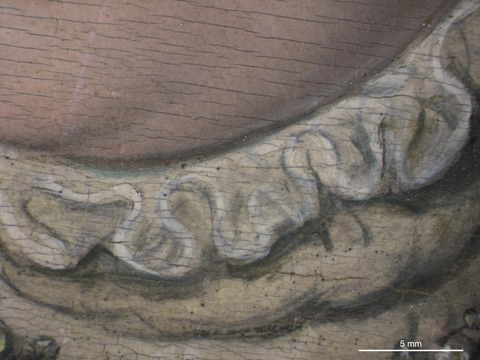
Painting Tools:
The paint was delicately applied in small brushstrokes and touches.
Binding Media:
The binding media was likely oil (untested).
Color Palette:
XRF analysis (tech. fig. 14) suggests the palette includes lead white, azurite, lead-tin yellow, carbon black, iron oxide (earth pigments), vermilion, and a calcium-containing (likely chalk) ground. The color palette conforms to that of the other Corneille de Lyon portraits in the Clowes Collection. The background is a light green color with slightly darker shading toward the edges. Like the Portrait of Marie de Guise, XRF analysis suggests the background is a mixture of lead white, azurite, and lead-tin yellow with a component of iron oxide (earth pigments) (tech. fig. 12). It is possible that the background mixture also includes a copper-containing green pigment, such as verdigris or copper resinate, but this has not been confirmed. The skin is painted using varying quantities of lead white, iron oxide (earth pigments), and vermilion. Azurite is mixed into the shadows to create a cool appearance (tech. fig. 13). Particles of azurite can be observed in the shadows using microscopy. The irises are painted using azurite outlined in black with subtle highlights applied in dabs of lead white. The figure’s clothing is primarily composed of carbon black and lead white. The hair is painted with alternating dark and light strokes of iron oxide (earth pigments) to create the illusion of waves. Some gold paint is noticeable in the sitter’s belt.
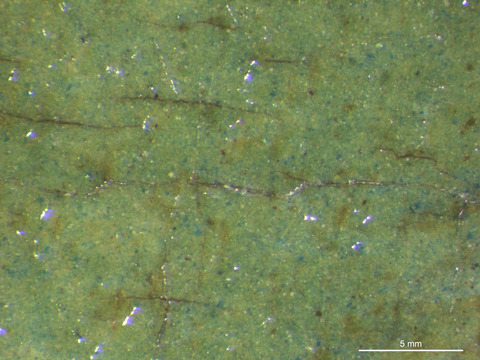
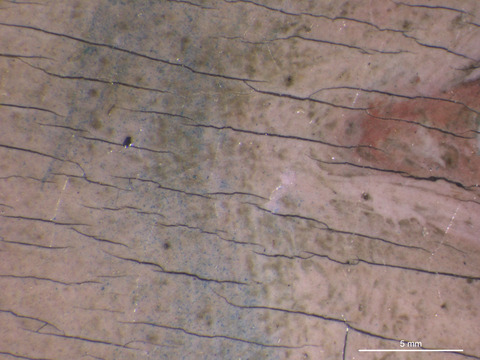
XRF Analysis:
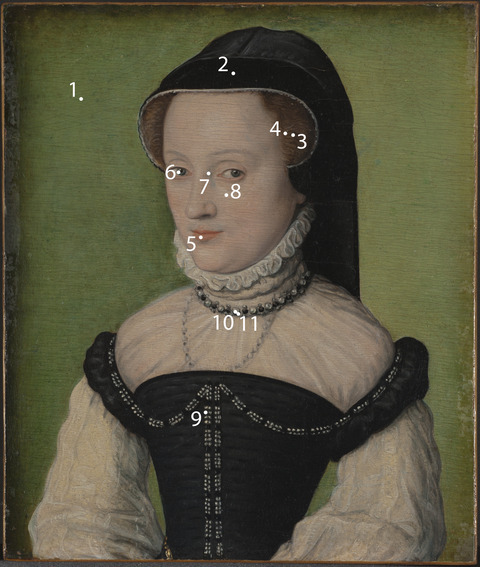
| Sample | Location | Elements | Possible Pigments |
|---|---|---|---|
| 1 | Green background | Major: Pb, Cu Minor: Trace: Fe, Ca, Sn | Lead white, azurite and/or copper-containing green pigment, trace of iron oxide (earth pigments), lead-tin yellow, calcium (likely from ground layer). |
| 2 | Black headdress | Major: Pb, Cu Minor: Trace: Fe, Ca | Lead white, carbon black pigment, trace of iron oxide (earth pigments), calcium (likely from ground layer). |
| 3 | Brown hair shadow | Major: Pb, Fe Minor: Cu Trace: Ca | Lead white, iron oxide (earth pigments), copper-containing green (or azurite), calcium (likely from ground layer). |
| 4 | Brown hair highlight | Major: Pb Minor: Fe, Cu Trace: Ca | Lead white, iron oxide (earth pigments), azurite and/or copper-containing green pigment, calcium (likely from ground layer). |
| 5 | Pink lip | Major: Pb Minor: Hg Trace: Ca | Lead white, vermilion, calcium (likely from ground layer). |
| 6 | Blue eye | Major: Pb, Cu Minor: Trace: Fe, Hg, Ca | Lead white, azurite, trace of iron oxide (earth pigments), trace of vermilion, trace of calcium (likely from ground layer). |
| 7 | Skin shadow | Major: Pb Minor: Cu, Hg Trace: Ca, Fe | Lead white, azurite, vermilion, trace of iron oxide (earth pigments), calcium (possibly from ground layer). |
| 8 | Skin shadow | Major: Pb Minor: Trace: Hg, Fe, Ca | Lead white, trace of vermilion, trace of iron oxide (earth pigments), calcium (possibly from ground layer). |
| 9 | White dot on dress | Major: Pb Minor: Trace: Fe, Ca, Cu | Lead white, trace of iron oxide (earth pigments), trace of azurite and/or copper-containing green pigment, calcium (possibly from ground layer). |
| 10 | Blue dot on pearl | Major: Pb, Cu Minor: Trace: Fe, Ca | Lead white, azurite, trace of iron oxide (earth pigments), calcium (possibly from ground layer). |
| 11 | Yellow dot on pearl | Major: Pb Minor: Trace: Fe, Ca, Cu, Sn | Lead white, azurite, lead-tin yellow, trace of iron oxide (earth pigments), calcium (possibly from ground layer). |
Table 1: Results of X-ray fluorescence analysis conducted with a Bruker Artax microfocus XRF with rhodium tube, silicon-drift detector, and polycapillary focusing lens (~100 μm spot).
*Major, minor, trace quantities are based on XRF signal strength not quantitative analysis
Surface Appearance:
Retouching covers some areas of paint loss in the sitter’s face, some small background losses, and losses around the edges of the painting. The retouching has discolored over time and does not entirely match the surrounding paint (tech. fig. 15). A few black specks are visible in many areas of the painting (tech. fig. 16); however, the cause is unknown. These are possibly related to the wood infestation or fly specks, but further analysis is necessary.
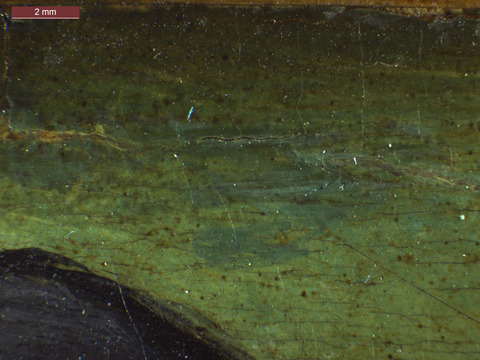
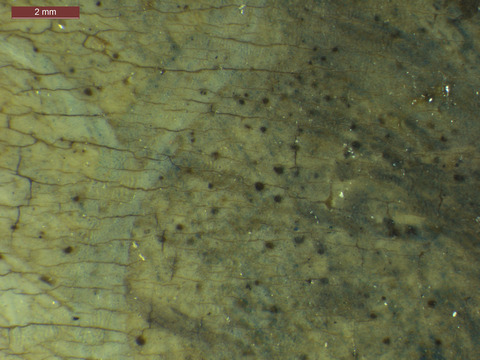
Condition of Paint
A micro cracking pattern due to the natural aging of the paint extends throughout the entire painting (tech. fig. 17). The cracking is horizontal and corresponds to the wood grain. Small paint losses are scattered throughout the painting. Some wear is visible around the perimeter of the painting where the paint is in contact with the frame. A few scratches occurred to the area of the sitter’s face, and these were subsequently inpainted during a previous conservation campaign. The paint is currently in stable condition.

Description of Varnish/Surface Coating
Analyzed Observed Documented
| Type of Varnish | Application |
|---|---|
| Natural resin | Spray applied |
| Synthetic resin/other | Brush applied |
| Multiple layers observed | Undetermined |
| No coating detected |
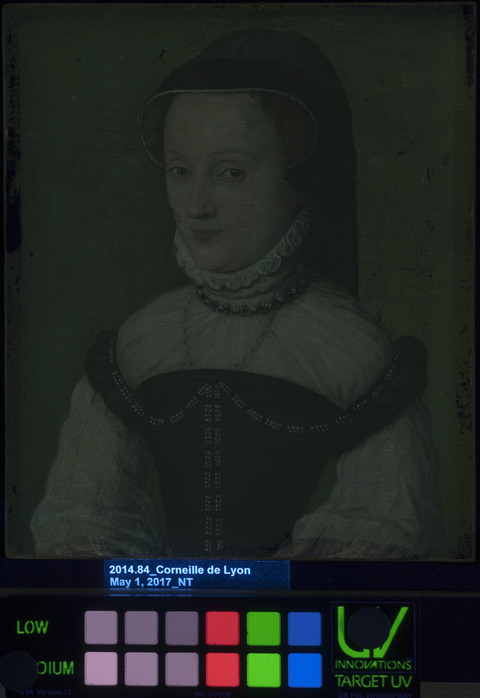
A very thin coat of a synthetic varnish (Paraloid B-82) is present over the entire surface of the painting, as indicated in the previous treatment report in the conservation file.6 The varnish appears slightly uneven and wrinkled in some areas. Under ultraviolet-induced visible fluorescence a coating of natural resin varnish appears to be present over the surface of the painting (tech. fig. 18). In visible light, the natural resin varnish can be clearly seen around the perimeter of the painting in the form of brownish yellow fluorescence, and overall the painting appears slightly yellowed as a result.
Condition of Varnish/Surface Coating
The most recently applied synthetic varnish is slightly wrinkled in appearance, possibly due to the application process or flow over time. The natural resin varnish was not removed, as evident from its green fluorescence in the ultraviolet-induced visible fluorescence photograph (tech. fig. 18), and it has yellowed over time. Small scuffs and abrasions are present in the varnish, particularly around the perimeter where the painting is in contact with the frame. Small areas of old retouching have discolored over time and no longer match the surrounding original paint layers.
Description of Frame
Original/first frame
Period frame
Authenticity cannot be determined at this time/ further art historical research necessary
Reproduction frame (fabricated in the style of)
Replica frame (copy of an existing period frame)
Modern frame
Frame Dimensions:
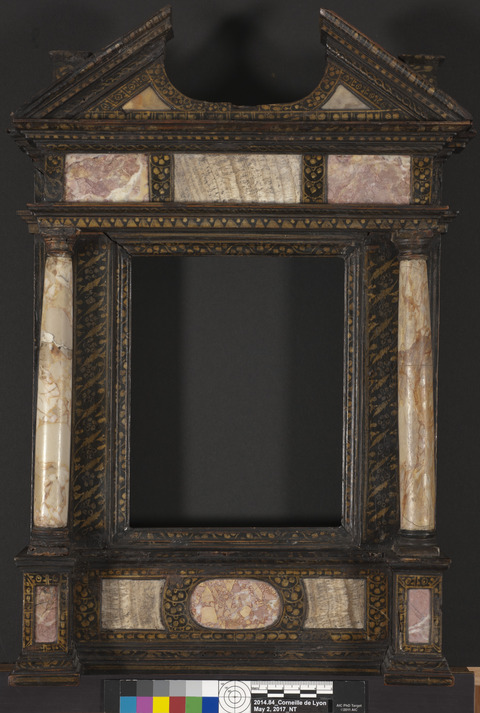
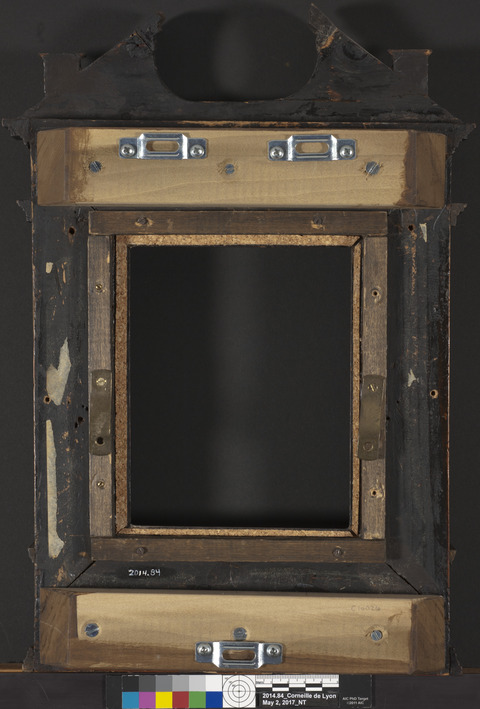
Outside frame dimensions: 43 × 27 cm (tallest point to widest point)
Sight size: 16.3 × 12.8 cm
Distinguishing Marks:
No stamps or labels are present on the frame.
Description of Molding/Profile:
The frame is a classic example of the aedicular type frequently associated with the works of Corneille de Lyon. Although there is no concrete evidence to suggest these frames are original to the artist, frame historian Maarten van ’t Klooster has pointed out that this style of Italianate frame would not have been out of step with the taste of the French court during Corneille’s lifetime, when Mannerist furniture was often inlaid with semiprecious stones. Indeed, while there is no firm evidence of their originality, most of the frames for the Corneille paintings in the Louvre collection are aedicular. This may have provided a sufficient body of evidence for dealers and museums to emulate this display in collections around the world.7
The frame was examined by Timothy Newbery at the Indianapolis Museum of Art. Newbery dated the frame to about 1610 and noted ornamental connections to Venice.8 This is consistent with van ’t Klooster’s suggestion that frames of this type have Italianate origins, particularly in Venetian lacquerware.9
The major structural components of this frame are wood with marble inserts used as decoration (tech. figs. 19, 20). The profile of the frame can be seen in technical figure 21. Two marble columns adorn either side (although the right one has been replaced with wood and painted to resemble marble). The wooden components are painted black with gold embellishments. Much of the painted areas are covered in a natural resin varnish. When viewed under ultraviolet-induced visible fluorescence (tech. fig. 22), the marble fluoresces differently in different areas, perhaps indicating different ages or types of marble were used in the construction of the frame.
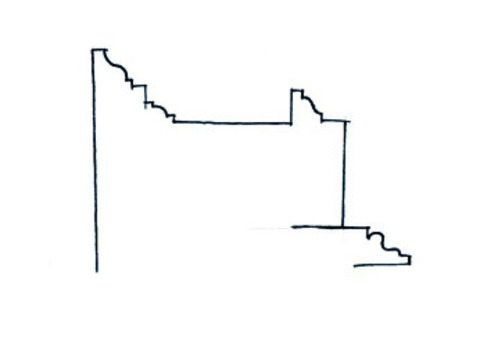
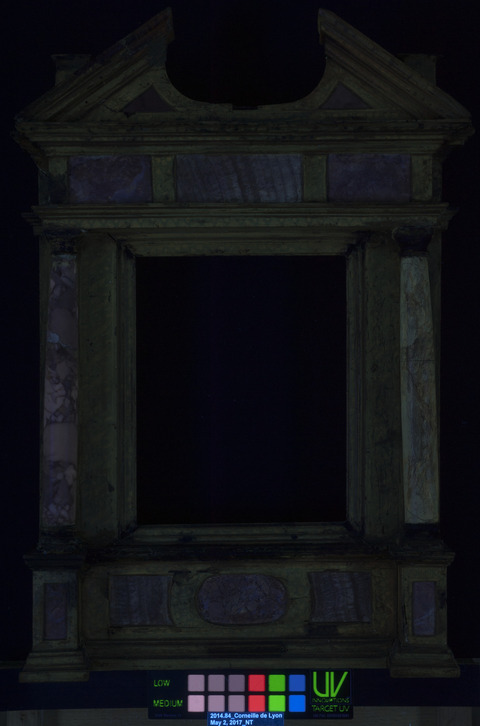
Condition of Frame
The frame is in relatively good condition despite the existence of several damage repairs. The proper left pillar has been replaced with wood and painted to resemble marble. The repair to the proper left column also exhibits a large crack through the center, and the finish is detaching along the bottom and may need consolidation. A few nicks and dents are present throughout the entire frame from general wear. When viewed under ultraviolet-induced visible fluorescence, abrasions to the varnish are noticeable, and some areas of retouching are present. Newbery states that the quality of the stone is good but recommends reworking of the adjustments. He also notes the central pinnacle in the pediment is missing.10
Notes
-
Paul A.J. Spheeris, “Conservation Report on the Condition of the Clowes Collection,” 25 October 1971, Conservation Department Files, Indianapolis Museum of Art at Newfields. ↩︎
-
Martin Radecki, Clowes Collection condition assessment, undated (after October 1971), Conservation Department Files, Indianapolis Museum of Art at Newfields. ↩︎
-
Intermuseum Conservation Association, “Clowes Collection Conservation Report,” C10026 (2014.84), 8–10 April 1974, Conservation Department Files, Indianapolis Museum of Art at Newfields. ↩︎
-
Memorandum from Carl J. Weinhardt to Martin J. Radecki, “Charges for Conservation of Objects in the Clowes Collection,” 15 February 1974, Conservation Department Files, Indianapolis Museum of Art at Newfields. ↩︎
-
Elvacite 2040 (synthetic resin) was used to fill the cradle while shooting the X-radiograph so that the appearance of the cradle would be minimized and allow the composition to be better interpreted. ↩︎
-
“Indianapolis Museum of Art Conservation Laboratory: Technical Record,” undated, File C10026, Conservation Department Files, Indianapolis Museum of Art at Newfields. ↩︎
-
Maarten van ’t Klooster, “Corneille de Lyon: French Portraits, Venetian Frames, Islamic Ornament,” The Frame Blog, 28 March 2019; https://theframeblog.com/2019/03/28/corneille-de-lyon-french-portraits-venetian-frames-islamic-ornament/#_ftnref8 ↩︎
-
Timothy Newbery, frame specialist, London, England. Visual analysis completed at the Indianapolis Museum of Art, 16 January 2012. ↩︎
-
Maarten van ’t Klooster, “Corneille de Lyon: French Portraits, Venetian Frames, Islamic Ornament,” The Frame Blog, 28 March 2019; https://theframeblog.com/2019/03/28/corneille-de-lyon-french-portraits-venetian-frames-islamic-ornament/#_ftnref8 ↩︎
-
Timothy Newbery, frame specialist, London, England. Visual analysis completed at the Indianapolis Museum of Art, 16 January 2012. ↩︎
Additional Images
